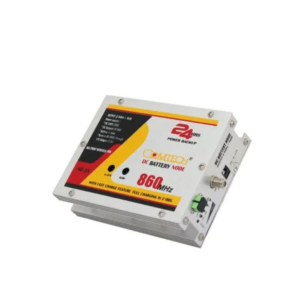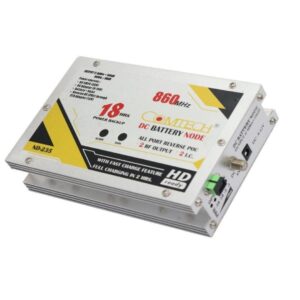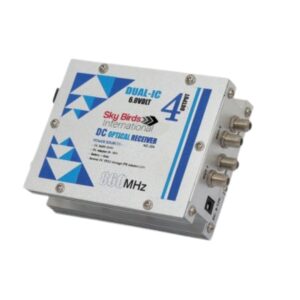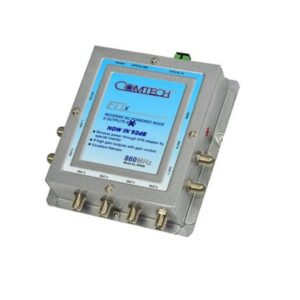Description
Multi Power Optical Receiver Node – Reliable Optical Signal Reception for Versatile Networks
The Multi Power Optical Receiver Node is a highly advanced and flexible device designed to meet the growing demands of modern optical communication systems. This receiver node supports multi-type power inputs, ensuring stable performance in various deployment environments including CATV, FTTx, and HFC networks. It plays a crucial role in converting incoming optical signals into high-quality RF outputs for further distribution to end-users.
With its compact design, superior signal sensitivity, integrated automatic gain control (AGC), and multi-power compatibility, this device is a smart investment for telecom operators, ISPs, and system integrators seeking reliability, efficiency, and ease of installation in their optical network deployments.
Key Features of Multi Power Optical Receiver Node
1. Multi Power Input Compatibility
One of the standout features of this receiver node is its support for multiple power input options – including DC, AC, and network-based powering. This flexibility makes it easy to install the device in diverse environments without the need for power conversion adapters. Whether you’re working in indoor racks or outdoor street cabinets, the device adapts effortlessly to the available power source.
2. High Optical Sensitivity
The Multi Power Optical Receiver Node features an advanced optical receiver module with high sensitivity that allows it to operate efficiently across a wide optical input range, usually from -9 dBm to +2 dBm. This ensures stable and consistent signal reception even when there are fluctuations in input power, enhancing reliability in large-scale networks.
3. Superior RF Output Performance
This device is engineered to deliver high-quality RF output with minimal noise and signal distortion. Its wide frequency response—typically up to 860 MHz or 1 GHz—ensures support for a full range of analog and digital TV signals, including HD content and broadband services. The output maintains a strong carrier-to-noise ratio (CNR), providing end-users with crystal-clear video and data services.
4. Automatic Gain Control (AGC)
The integrated AGC functionality automatically adjusts the RF output level based on variations in optical input, maintaining consistent signal strength for downstream devices. This smart feature significantly reduces the need for manual calibration, simplifying network operations and ensuring optimal performance around the clock.
5. Compact and Durable Construction
Built for field use, the Multi Power Optical Receiver Node features a compact, weatherproof enclosure with high durability, typically IP65-rated. Its rugged design resists dust, water, and physical impacts, making it ideal for both indoor equipment racks and harsh outdoor installations.
6. LED Status Indicators
The receiver is equipped with intuitive LED indicators for power, optical signal presence, and AGC status, allowing technicians to easily monitor the device’s operational status during installation or maintenance checks. This makes troubleshooting quicker and more efficient.
7. Energy Efficient Operation
Designed with power-saving technology, the receiver node consumes minimal energy during operation, making it a cost-effective choice for large-scale fiber optic deployments. Its efficient power usage also helps extend the lifespan of connected components and reduces long-term operational expenses.
Applications of Multi Power Optical Receiver Node
1. Fiber to the Home (FTTH) Systems
In FTTH installations, this optical receiver is placed at the end of the optical network to convert the incoming signal into RF, which is then distributed to the end-user’s home. Its high sensitivity and stable output ensure superior customer experience.
2. Hybrid Fiber-Coaxial (HFC) Networks
For HFC systems, the receiver node acts as a key interface between the optical trunk and coaxial distribution networks, delivering strong RF output across multiple user connections without signal degradation.
3. CATV & Digital TV Broadcasting
This receiver supports analog and digital CATV signals, making it a valuable component in cable television networks. Its wide frequency support allows broadcasters to offer a broad range of channels, including high-definition and interactive services.
4. Campus and Commercial Building Networks
Due to its multi-power capabilities, this receiver is ideal for use in complex environments like university campuses, business parks, and multi-story commercial buildings where power sources vary from location to location.
Advantages of Choosing the Multi Power Optical Receiver Node
-
✅ Flexible power input options (DC, AC, network)
-
✅ High-sensitivity optical reception
-
✅ Excellent RF signal performance with AGC
-
✅ Compact and rugged for all environments
-
✅ Low power consumption and LED diagnostics
-
✅ Perfect for FTTH, HFC, CATV, and broadband services
Conclusion
The Multi Power Optical Receiver Node is a versatile, high-performance solution tailored to the dynamic needs of modern optical communication infrastructures. With its adaptable power input design, high optical sensitivity, automatic gain control, and robust build, it ensures optimal network performance and simplified operations. Whether for urban, rural, or mixed network environments, this receiver node delivers reliable signal conversion and distribution, ensuring your network remains stable, efficient, and future-ready.






Reviews
There are no reviews yet.